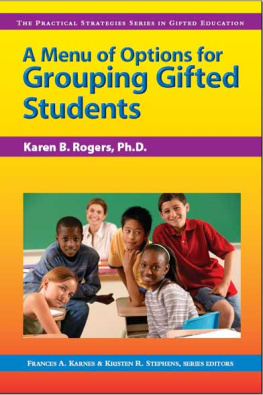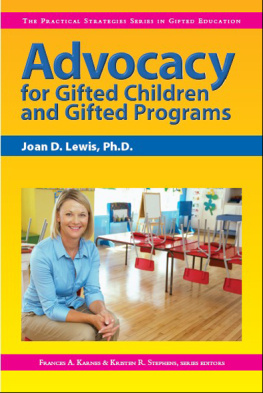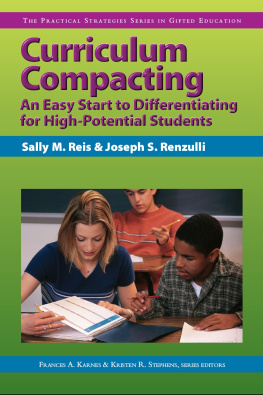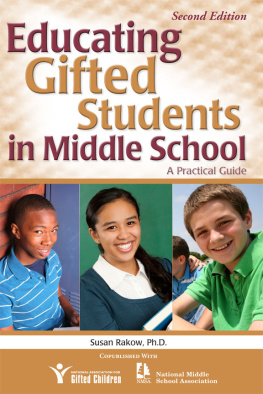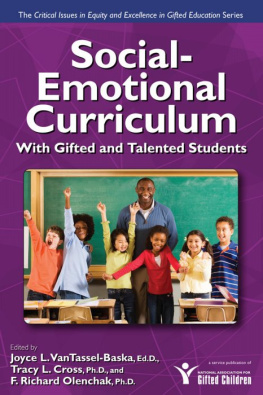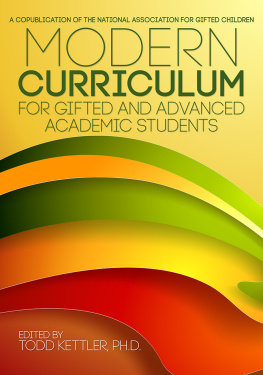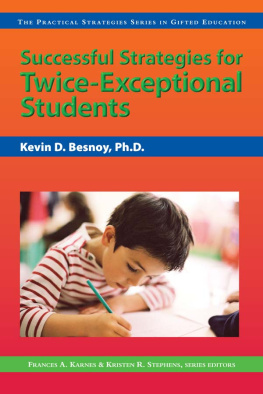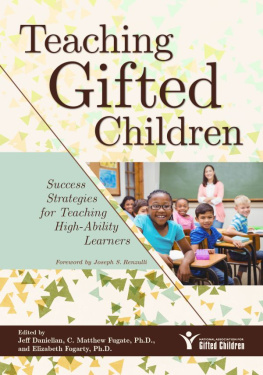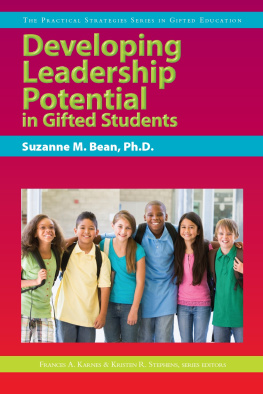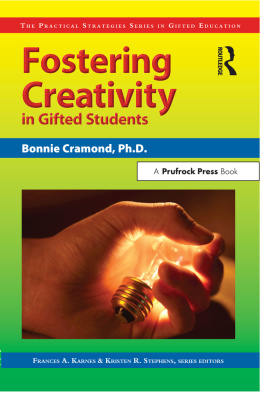
Copyright 2018, 2012, 2001, 1992 by Susan Winebrenner, M.S., and Dina Brulles, Ph.D.
All rights reserved under International and Pan-American Copyright Conventions. Unless otherwise noted, no part of this book may be reproduced, stored in a retrieval system, or transmitted in any form or by any means, electronic, mechanical, photocopying, or otherwise, without express written permission of the publisher, except for brief quotations or critical reviews. For more information, go to www.freespirit.com/permissions.
Free Spirit, Free Spirit Publishing, and associated logos are trademarks and/or registered trademarks of Free Spirit Publishing Inc. A complete listing of our logos and trademarks is available at www.freespirit.com.
Library of Congress Cataloging-in-Publication Data
Winebrenner, Susan.
Teaching gifted kids in todays classroom : strategies and techniques every teacher can use / Susan Winebrenner, Dina Brulles. Rev. & updated third ed.
p. cm.
Rev. ed. of: Teaching gifted kids in the regular classroom, c2001.
Summary: Fully revised and updated for a new generation of educators, this is the definitive guide to meeting the learning needs of gifted students in the mixed-abilities classroomseamlessly and effectively with minimal preparation time. For years, teachers have turned to this book daily to ensure their gifted students are getting the opportunities they need and deserve. Included are proven, practical, classroom-tested strategies and step-by-step instructions for how to use them. The new edition of Teaching Gifted Kids in Todays Classroom provides information on using technology for accelerated learning, managing cluster grouping, increasing curriculum rigor, improving assessments, boosting critical and creative thinking skills, and addressing gifted kids with special needs. Already a perennial best seller, this guides third edition is sure to be welcomed with open arms by teachers everywhere.Provided by publisher.
ISBN 978-1-57542-395-1 ISBN 1-57542-395-2
1. Gifted childrenEducationUnited States. I. Brulles, Dina. II. Winebrenner, Susan, Teaching gifted kids in the regular classroom. III. Title.
LC3993.9.W56 2012
371.95dc23
2012024020
Updated Fourth Edition ISBN: 978-1-63198-372-6
Free Spirit Publishing does not have control over or assume responsibility for author or third-party websites and their content. At the time of this books publication, all facts and figures cited within are the most current available. All telephone numbers, addresses, and website URLs are accurate and active; all publications, organizations, websites, and other resources exist as described in this book; and all have been verified as of June 2018. If you find an error or believe that a resource listed here is not as described, please contact Free Spirit Publishing. Parents, teachers, and other adults: We strongly urge you to monitor childrens use of the internet.
The Compactor form introduced in chapter 2 and used throughout the book is adapted from a document originally published in 1978 by Creative Learning Press. Used with permission from Creative Learning Press.
Edited by Meg Bratsch
Cover and interior design by Michelle Lee Lagerroos
Free Spirit Publishing Inc.
6325 Sandburg Road, Suite 100
Minneapolis, MN 55427-3674
(612) 338-2068
www.freespirit.com
Free Spirit offers competitive pricing.
Contact for pricing information on multiple quantity purchases.
Dedication
This book is dedicated to all the educators who have found its previous editions so helpful, and who have consistently spread the word to colleagues far and wide. We are forever in your debt!
Acknowledgments
Sincere thanks go to:
Contributing author, Dr. Dina Brulles, for her helpful perspectives on the realities of current educational best practices, and for her significant contributions to the third and fourth editions.
Our editor, Meg Bratsch, for her patience and dedication in working tirelessly to confirm that the ideas expressed in the book are clearly communicated to you, its readers.
Our publisher, Judy Galbraith, whose diligent efforts over the years continue to ensure that all kids get the understanding and support they deserve.
Teachers Karen L. Brown, Karen Mensing, Erica Bailin, Alys Carnesi, and David Graham in the Paradise Valley Unified School District in Arizona, for their contributions in the areas of technology and assessment.
And last, but certainly not least, to Susans husband, Joe, whose amazing patience with the demands of this most time-consuming task surely demonstrates how fortunate she is to share her life with him.
Contents

Digital Content
To access this books digital content and download the reproducible forms, visit freespirit.com/tgk-forms. Use the password 4gifted.
Chapter 10: Parenting Gifted Children
Additional Extension Menus
PDF Presentation for Professional Development
Reproducible Pages from the Book
List of Reproducible Pages
Chapter 1
Chapter 2
Chapter 3
Chapter 4
Chapter 5
Chapter 6
Chapter 9
List of Figures
Foreword
by Bertie Kingore, Ph.D.

Is the word classic overused? Not when referencing this book. Teaching Gifted Kids in the Regular Classroom (its original title) is a true classic in gifted education. Susan Winebrenners first and second editions transformed how gifted children are perceived and nurtured in mixed-ability classrooms. At the university level, both my undergraduate and graduate in-service teachers were enriched by the content and spirit of this book and perceived immediate connections that influenced their interactions with gifted students.
With Dina Brulles, the impact continues with a third, and now fourth, edition: Teaching Gifted Kids in Todays Classroom. The title change is most appropriate, as this work explores applications in contemporary education and more authentic learning initiatives, including the changes implied by the required standards that are integrated throughout the book.
This new edition continues the tradition of excellence with updated content, new topics, expanded resources, and the addition of Dr. Brulless field experience and research in school systems. The book is a pleasure to read. It is well-crafted with practical applications that demonstrate how to address the two crucial needs of gifted students: compacting and differentiation. The discussion and applications of curriculum compacting and differentiation techniques are succinct, clear, and absolutely manageablethe best available to teachers. Compacting is particularly crucial for gifted students to enable them to experience continuous learning and avoid the less meaningful repetition of known concepts and skills.
The added chapter and expanded emphasis on assessment and technology is timely and sorely needed. The authors build a solid case for effectively combining the two for increased interest and achievement outcomes. They provide numerous, ready-to-use formative assessment techniques in keeping with required standards and the increased emphasis on continual assessments by most schools. Educators must use preassessment and formative assessment to document that gifted students have changed as learners as a result of classroom learning. Assessment is also vital to ensure that gifted students experience continuous progress in all content areas.



